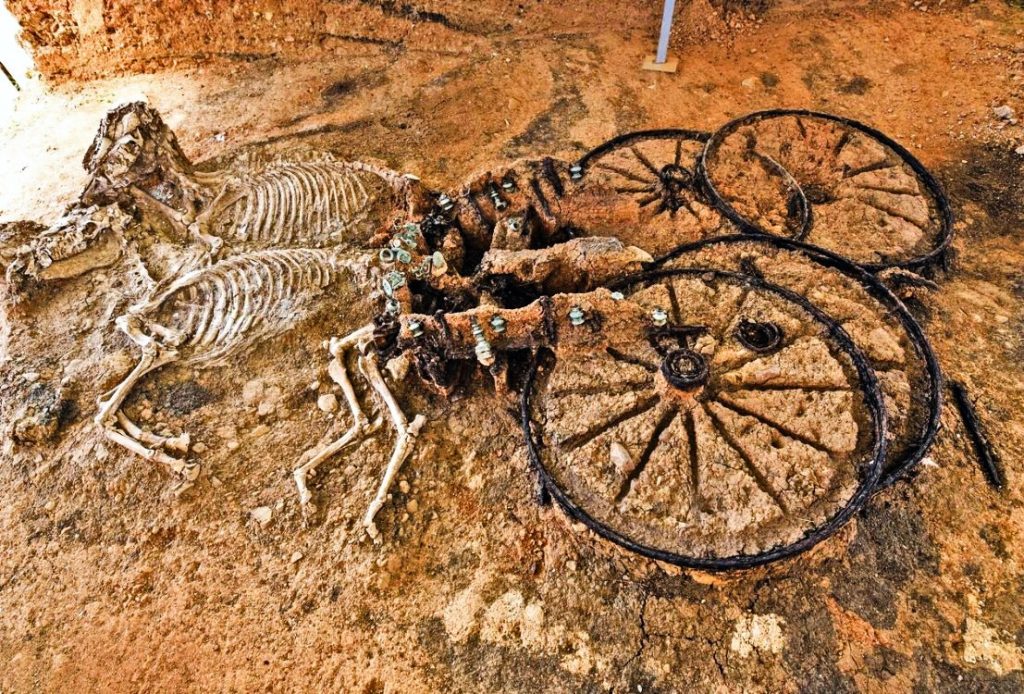In the heart of rural Bulgaria, an extraordinary archaeological discovery has captured the imagination of historians and enthusiasts alike: a 2,000-year-old wooden chariot intricately adorned with scenes from Thracian mythology. This remarkable artifact provides a captivating glimpse into the burial practices, artistic achievements, and spiritual beliefs of the ancient Thracian civilization, a society that once flourished in this region and played a pivotal role in shaping its cultural landscape.
The Chariot of the Aristocrat: A Marvel of Craftsmanship
Unearthed from the tomb of a prominent Thracian aristocrat dating back to the 1st century A.D., this chariot is a true testament to the sophistication of ancient craftsmanship. Featuring four massive wheels, each measuring an impressive four feet in diameter, the chariot is adorned with silver-coated depictions of the god Eros and mythical creatures resembling panthers. These elaborate decorations not only highlight the advanced artistic skills of the Thracians but also reflect the importance of mythology in their daily lives and afterlife beliefs.

A Journey to the Afterlife: Companion Animals in Burial Rites
Accompanying the chariot were the skeletal remains of two horses and a dog, carefully placed within the tomb. These animals were likely intended to serve the deceased in the afterlife, providing both transportation and companionship. This practice underscores the centrality of afterlife preparations in Thracian funerary customs, where burial rites were deeply intertwined with their belief in a better existence beyond the mortal realm. The inclusion of these animals highlights the profound relationship between the Thracians and the natural world, as well as their conviction that life extended beyond death.
Uncovering Thracian Beliefs and Customs: Elaborate Burial Practices
The discovery of this ancient chariot sheds light on the elaborate burial practices of the Thracian people. It was customary to include objects that the deceased might need in the afterlife, with the wealth and status of the individual determining the extravagance of the burial. For aristocrats and nobles, burial gifts were often opulent and meticulously crafted, reflecting their high social standing and the respect they commanded within their communities. The chariot, with its intricate decorations and symbolic significance, serves as a powerful indicator of the deceased’s elevated status and the cultural importance of honoring the dead with grandeur.
A Glimpse into the Past: Artifacts Beyond the Chariot
In addition to the chariot and animal remains, archaeologists uncovered a trove of artifacts that further illuminate the lives of the ancient Thracians. These included pottery, glass vessels, and exceptionally well-preserved wooden and leather items, some of which are believed to have been horse harnesses. The meticulous placement of these objects within the funerary mound suggests a deliberate effort to ensure the deceased was well-equipped for the journey to the afterlife. These findings provide a vivid snapshot of the material culture of the Thracians, offering valuable insights into their daily lives, artistic endeavors, and spiritual practices.
Preserving a Piece of History: A Cultural Legacy
The bronze-plated wooden chariot, with its stunning mythological decorations, stands as a testament to the rich cultural heritage of the Thracian civilization. Its discovery highlights not only the advanced craftsmanship of these ancient people but also their deeply held beliefs and traditions. The intricate designs and high-quality materials used in the chariot’s construction demonstrate the Thracians’ artistic prowess and their ability to create objects of both functional and symbolic value. This artifact serves as a powerful reminder of the importance of preserving and studying our shared history, enabling us to better understand the civilizations that came before us and their lasting influence on the world today.
A Captivating Reminder of Our Shared Heritage
As we continue to unearth the secrets of the past, discoveries like the 2,000-year-old Thracian chariot remind us of the fascinating and diverse cultures that have shaped human history. This extraordinary find is more than just an archaeological treasure; it is a tangible link to a civilization that valued artistry, mythology, and the afterlife. By studying such artifacts, we gain a deeper appreciation for the ingenuity and resilience of our ancestors, as well as the universal human desire to leave a lasting legacy.
The Thracian chariot, with its intricate craftsmanship and symbolic significance, offers a window into a world that was both remarkably advanced and deeply connected to its spiritual and cultural roots. Its discovery not only enriches our understanding of Thracian society but also underscores the enduring power of archaeology to illuminate the human experience across centuries. As we reflect on this remarkable piece of history, we are reminded of the importance of preserving the stories and achievements of ancient civilizations, ensuring that their legacy continues to inspire and educate future generations.
In essence, the Thracian chariot is not merely an artifact; it is a story etched into wood and metal, a narrative of a people who sought to honor their dead with grandeur and artistry. It stands as a symbol of the enduring connection between past and present, a testament to the Thracians’ remarkable contributions to human history, and a reminder of the endless possibilities that lie hidden beneath the surface, waiting to be discovered and cherished. This captivating find encourages us to look beyond the ordinary and uncover the extraordinary, celebrating the rich tapestry of cultures that have shaped the world we live in today.





